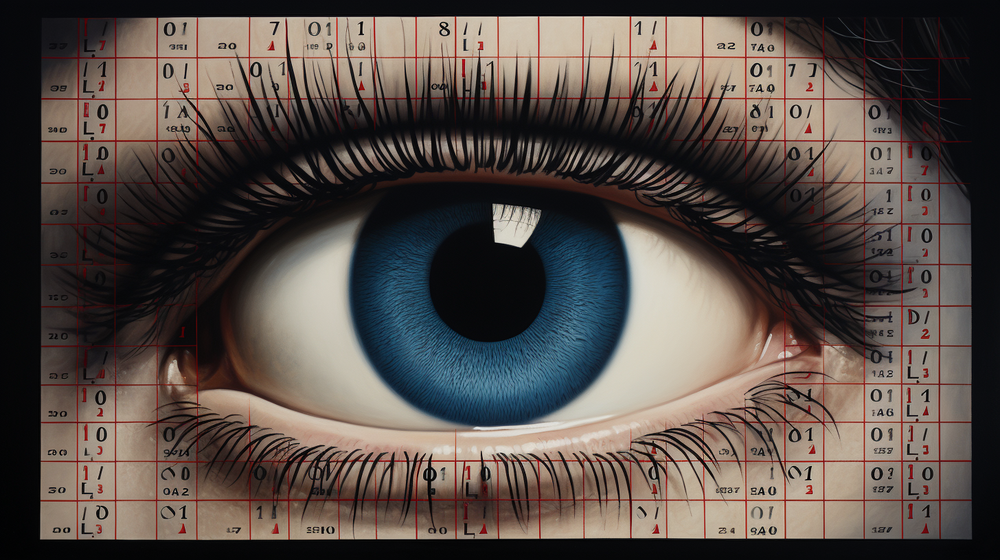You have no items in your shopping cart.

You're over 40 and your vision isn't what it used to be? You're not alone. Many age-related eye problems are common and can be managed with proper care.
We'll explore the most common ones like age-related macular degeneration, diabetic retinopathy, and glaucoma.
Key Takeaways
- Cataracts, glaucoma, retinal detachment, conjunctivitis, and amblyopia are common eye problems.
- Age-Related Macular Degeneration (AMD) can be caused by uncontrolled diabetes, high blood pressure, smoking, eye diseases or accidents, and genetic factors.
- Symptoms of AMD include blurred or cloudy vision, glare or ring around lights, floating spots, sensitivity to light, and headaches.
- Regular eye examinations, healthy lifestyle choices, and control of blood sugar, cholesterol levels, and smoking can help prevent AMD.
What are Eye Problems?
Eye problems are medical conditions that can affect your vision and overall eye health.
From cataracts to glaucoma, there's a wide range of issues you can encounter, but in this article we’ll discuss the most common ones..
Types of Common Eye Problems
Surprisingly, you're more likely to experience one of the common eye problems, such as retinal detachment or conjunctivitis, during your lifetime. These types of common eye problems can range from mild irritations to serious conditions that require immediate medical attention.
You might be born with amblyopia, also known as lazy eye, or strabismus, a condition where your eyes don't line up. Other common eye disorders include floaters, those tiny specks that drift across your vision, and refractive eye conditions like presbyopia, which causes difficulties in focusing on close objects. Conditions like dry eye and eye tearing are also prevalent.
Treatments vary from eyeglasses and contacts to medications, laser treatments, and even surgery. Understanding these common eye diseases can help you protect your vision.
Age-Related Macular Degeneration (AMD)
You've probably heard of Age-Related Macular Degeneration (AMD), but do you know what causes it or the symptoms to watch out for?
It's crucial to understand its diagnosis, treatment options, and risk factors. And wouldn't it be great to know how to prevent it?
Causes of AMD
You're more susceptible to AMD, an age-related macular degeneration, if you've uncontrolled diabetes, high blood pressure, or if you're a regular smoker. These are significant risk factors that contribute to the disease progression.
This common age-related eye condition is primarily caused by loss of sight due to eye diseases, accidents, or conditions like diabetes that damage the optic nerve.
Some medications can also increase your risk. Your genetic factors play a role too, especially if you're of African American or Hispanic descent. Poor blood sugar control and high cholesterol levels can further increase your chances. Even pregnancy can make you more prone.
Symptoms of AMD
Even though you're not experiencing pain, if you're noticing symptoms of AMD like blurred or cloudy vision, seeing a glare or ring around lights, floating spots, sensitivity to light, or headaches, it's time to seek medical attention.
Age-Related Macular Degeneration is a common eye problem and a degenerative disease that can lead to severe vision loss if left untreated. Don't overlook these symptoms as they can gradually worsen over time. It's not just about the discomfort, but about preserving your sight.
As one of the most common eye problems, AMD shouldn't be taken lightly. So, if you're experiencing any symptoms of AMD, don't hesitate to consult an eye specialist.
Always remember, early detection and treatment can help slow down the progression of this degenerative disease.
Diagnosis and Treatment for AMD
Once you've noticed any symptoms of AMD, the next step is to get a comprehensive eye exam for a proper diagnosis and to understand the treatment options available to you.
This exam can specifically detect any degeneration in your central vision.
Medical treatment for AMD varies but can include laser treatment or eye injections.
Laser treatment targets abnormal blood vessels in your eyes, slowing down the degeneration and preserving your vision.
Eye injections, on the other hand, can halt the growth of these damaging blood vessels.
Remember, regular eye exams are crucial for monitoring your condition.
They'll help you stay one step ahead of AMD.
So, don't underestimate the importance of keeping up with them.
Your sight's worth it.
Key takeaway : Get regular eye examinations and ask the doctor about treatments to slow eye degeneration.
Risk Factors for AMD
You've got to keep an eye on your blood sugar and cholesterol levels, and quit smoking because these are significant risk factors for AMD, one of the most common eye diseases. Poor control of these factors can contribute to the development of this genetic condition, leading to severe vision impairment.
Maintaining your eye health should be a priority, especially if you have type 1 or type 2 diabetes. High blood pressure is another risk factor that can exacerbate AMD.
It's crucial to have regular comprehensive eye exams to monitor any potential changes in your eye health. By managing these risk factors effectively, you're reducing your chances of developing AMD, and ensuring a clear and healthy vision for years to come.
Prevention of AMD
In managing your blood sugar and cholesterol levels, and avoiding smoking, you're taking crucial preventive measures against AMD. AMD, or age-related macular degeneration, is a common condition that can lead to significant vision loss if not prevented or managed effectively. But don't worry, there are several strategies you can employ for the prevention of AMD.
- Regular eye examinations: These help detect the early forms of the disease, allowing for timely treatment.
- Healthy lifestyle choices: Including a balanced diet and regular exercise.
- Control of blood sugar: Especially important if you're a diabetic.
Diabetic Retinopathy
Diabetic retinopathy is a diabetes complication that affects eyes. It's caused by damage to the blood vessels of the light-sensitive tissue at the back of the eye (retina). At first, diabetic retinopathy may cause no symptoms or only mild vision problems.
Eventually, it can cause blindness. It can occur in anyone who has type 1 or type 2 diabetes. The longer you have diabetes and the less controlled your blood sugar is, the more likely you are to develop this eye complication.
Causes of Diabetic Retinopathy
Over time, as a result of diabetes, you'll notice that biochemical changes can cause damage to the tiny blood vessels in your retina, leading to diabetic retinopathy. This complication of diabetes can severely affect your vision if not managed properly.
The causes of diabetic retinopathy can be attributed to several factors:
- Poor control of blood sugar levels: This is the primary cause for people with diabetes. High blood sugar levels can lead to damaged blood vessels in the retina.
- Duration of diabetes: The longer you've had diabetes, the greater your risk.
- High blood pressure: This can exacerbate the damage to the retinal blood vessels.
Symptoms of Diabetic Retinopathy
Experiencing symptoms like blurred vision, gradual vision loss, floaters, shadows in your vision, or difficulty seeing at nighttime could indicate you're dealing with diabetic retinopathy. Diabetic retinopathy is a complication of diabetes that affects the eyes. High blood sugar levels can cause damage to blood vessels in the retina, leading to these symptoms.
Over time, the disease can worsen, causing more severe vision problems. It's crucial to manage your blood sugar levels to mitigate these effects. If you're noticing any symptoms of diabetic retinopathy, don't ignore them. It's serious and can lead to total vision loss if left untreated.
Be proactive about your eye health, and consult an eye specialist if you're experiencing any of these symptoms.
Diagnosis and Treatment for Diabetic Retinopathy
Interestingly, for the diagnosis of diabetic retinopathy, you'll undergo a comprehensive eye exam, and if detected, treatments like laser surgery, vitrectomy or injections can be effective in managing the disease. This common complication of diabetes can harm your visual acuity, so it's crucial to keep an updated eyeglass prescription.
- Look for signs of keratoconus, a condition that may also affect your sight.
- Regular check-ups help detect diabetes-related retinopathy in its early stages.
- Be aware of blurred vision, a potential symptom of retinopathy.
Risk Factors for Diabetic Retinopathy
Why haven't we considered the role your high blood pressure and cholesterol levels might be playing as risk factors in your diabetic retinopathy? We've focused heavily on the duration of your diabetes and how well you're controlling your blood sugar, but perhaps we've overlooked something.
As you know, diabetic retinopathy is often associated with abnormal blood vessels in the eye. Blood pressure and cholesterol can influence the health of these vessels. If you have a history of eye disease, this could also increase your risk of diabetic retinopathy.
Regular eye checks are essential, even if your vision seems fine. And remember, if you're pregnant, these checks need to be more frequent. It's all about managing your risk factors effectively.
Prevention of Diabetic Retinopathy
Before the onset of any symptoms, you should be getting regular eye examinations to prevent diabetic retinopathy. This is one of the common forms of eye problems arising from health conditions like diabetes. Early detection is crucial, as it allows for timely treatment and can help halt the progression of the disease.
To further reinforce prevention of diabetic retinopathy, consider the following:
- Manage diabetes diligently: Keep your blood sugar levels under control.
- Maintain a healthy lifestyle: Regular exercise and a balanced diet can reduce the risk.
- Regular follow-ups with your doctor: They can monitor your condition and adjust treatments as necessary.
Glaucoma
Glaucoma is a complex, multifaceted eye disease that primarily affects the optic nerve, an essential part of the eye responsible for vision. The optic nerve gets damaged usually because of high intraocular pressure, which is a result of an imbalance in the production and drainage of the fluid in the eye. Over time, exacerbated pressure in the eye can erode the optic nerve tissues, leading to a gradual loss of vision. It's worth noting that glaucoma is one of the leading causes of irreversible blindness worldwide, particularly in individuals aged 60 and above.
There are different types of glaucoma, with the most common being open-angle glaucoma and angle-closure glaucoma. Open-angle glaucoma, frequently linked to genetic factors, exhibits no early symptoms and vision loss is often gradual. In contrast, acute angle-closure glaucoma often presents sudden symptoms like severe eye pain, nausea, red eyes, and blurred vision, requiring immediate medical attention.
Treatment for glaucoma typically involves medication or surgery with the goal of reducing intraocular pressure. However, the damage caused by glaucoma cannot be reversed, and it's crucial to have regular eye check-ups that can help detect the condition in its early stages. Despite its potential seriousness, with early diagnosis and treatment, you can often protect your eyes against severe vision loss or blindness.
Be vigilant about your eye health. Regular check-ups can catch glaucoma early and help prevent serious vision loss.

Frequently Asked Questions
What Are Some Preventive Measures for Common Eye Problems?
You're asking about preventive measures. Regular eye check-ups, wearing sunglasses, maintaining a healthy diet, not smoking, and taking frequent breaks when working on screens can help prevent potential issues.
How Does Diet and Lifestyle Affect Eye Health?
Your diet and lifestyle significantly impact your eye health. Consuming foods rich in vitamins A, C, and E, and maintaining a healthy weight can prevent eye issues. Regular exercise also boosts overall eye health.
Can Exercising Regularly Help in Reducing the Risk of Eye Problems?
Absolutely, regular exercise can help reduce your risk of eye problems. It improves blood circulation, which enhances overall eye health. So, you're not just shaping up your body, but your eyes too!
How Often Should One Go for Eye Check-Ups?
You should aim for an eye check-up every two years. But if you're over 60 or have a condition like diabetes, you'll need annual check-ups. It's always best to follow your optometrist's advice.
What Is the Difference Between Nearsightedness and Farsightedness?
You're nearsighted if you can't see far objects clearly, while you're farsighted if near objects appear blurry. It's about how your eye focuses light, either in front or behind your retina, respectively.
Conclusion
So, you've learned about common eye problems like Age-Related Macular Degeneration, Diabetic Retinopathy, and Glaucoma. It's crucial to get regular eye check-ups to catch these conditions early.
Don't ignore any eye discomfort or vision changes. Take care of your eye health - it's vital for your overall well-being.
Remember, early detection and treatment can make a world of difference, so don't take your eyes for granted!

This information is intended solely for New Zealand residents and is of a general nature only. No person should act in reliance on any statement contained in the information provided, but at all times should obtain specific advice from a health professional.
